 Backend Development
Backend Development
 PHP Tutorial
PHP Tutorial
 What is middleware? Listen to Miejieshi Taiqu talk about laravel middleware (picture)
What is middleware? Listen to Miejieshi Taiqu talk about laravel middleware (picture)
What is middleware? Listen to Miejieshi Taiqu talk about laravel middleware (picture)
What is middleware? Listen to Master Mieke talk about laravel middleware (picture)
This article mainly introduces what is middleware? I heard Miaojueshi Taiqu talk about laravel middleware (picture), which has a certain reference value. Now I share it with everyone. Friends in need can refer to it
What is middleware? As the name suggests, middleware is the middleware, the middle layer, that filters some requests, such as some simple token verification; the following article explains in detail the methods and techniques of defining middleware and registering middleware in Laravel.
1. Define middleware
The labeled laravel can be defined directly in the command
php artisan make:middleware CheckToken
This way it is created There is a middleware class called CheckToken. This class is in the /app/Http/Middleware directory:
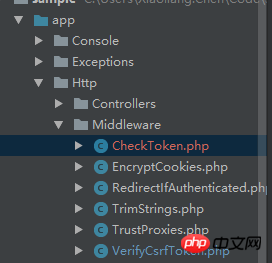
After clicking it, the code will look like this:
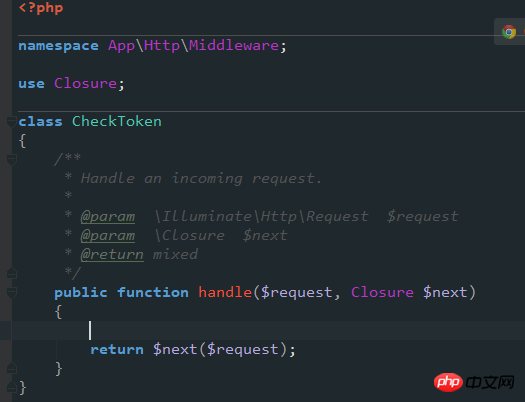
Then you can go and write something in it. For example:
public function handle($request, Closure $next)
{
if($request->input('token')!='minxintoken'){
return redirect()->to('http://www.baidu.com');
}
return $next($request);
}The meaning is obvious. If the 'token' field in the sent data is not equal to minxintoken, then it will automatically jump to http://www.baidu.com
Of course, so far, we have only created a middleware called CheckToken, but it has not been enabled; now let’s enable it;
2. Register the middleware
The so-called activation is to register this middleware into the specified route;
There are two types of registration, global middleware and specified route middleware,
1. Global Middleware:
As long as the corresponding middleware is added to the array attribute $middleware of app/Http/Kernel.php, it will be ok: (CheckToken::class written directly in the original text will not work and will report to App\Http\ CheckToken does not exist, you need to add the namespace of CheckToken.php to get the CheckToken correctly)
The correct answer is as follows:

Enter sample.test/ directly in the browser about will jump directly to www.baidu.com, but it won’t work like this:
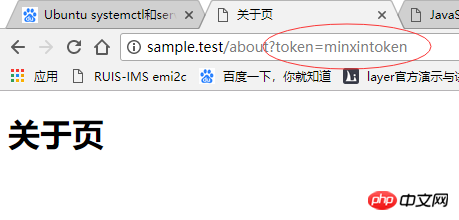
ok Global registration ends here. Generally speaking, global settings are not recommended. I don’t agree, because it is really annoying to bring the token every time;
2. Then let’s take a look at the middleware that specifies the route,
This kind of middleware To install the file, you first need to assign a key to the middleware in app/Http/Kernel.php and add it to $routeMiddleware in the file. There are already many default keys in it, just add one at the end:

After adding the key, go to the routing file and enable
Route::get('/','StaticPagesController@home')->middleware('token');
The effect of accessing the browser is to directly enter sample.test/ and it will be redirected to Baidu, and enter sample .test/?token=minxintoken can enter the homepage
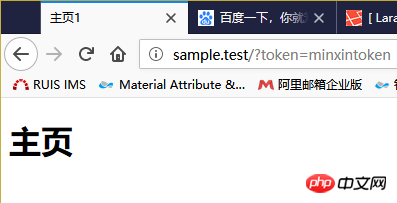
Of course, the disadvantage of this is that you have to tap a route to use it, which is not normal; so Another cool operation is that there is an array called $middlewareGroups in the Kernel.php file: We add the CheckToken we just created in the web,
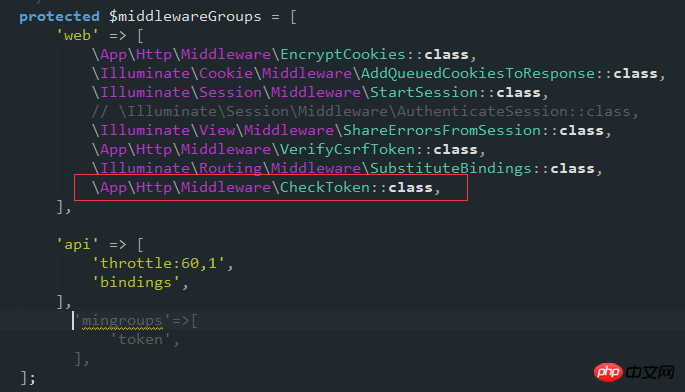
and then all The things in /route/web.php require token=minxintoken to access; for example, sample.test/ sample.test/about sample.test/help, etc.;
The above is the entire content of this article , I hope it will be helpful to everyone’s learning. For more related content, please pay attention to the PHP Chinese website!
Recommended courses:
The latest laravel mall practical video tutorial
Comprehensive interpretation of the Laravel framework and practical video tutorial
The above is the detailed content of What is middleware? Listen to Miejieshi Taiqu talk about laravel middleware (picture). For more information, please follow other related articles on the PHP Chinese website!

Hot AI Tools

Undresser.AI Undress
AI-powered app for creating realistic nude photos

AI Clothes Remover
Online AI tool for removing clothes from photos.

Undress AI Tool
Undress images for free

Clothoff.io
AI clothes remover

AI Hentai Generator
Generate AI Hentai for free.

Hot Article

Hot Tools

Notepad++7.3.1
Easy-to-use and free code editor

SublimeText3 Chinese version
Chinese version, very easy to use

Zend Studio 13.0.1
Powerful PHP integrated development environment

Dreamweaver CS6
Visual web development tools

SublimeText3 Mac version
God-level code editing software (SublimeText3)

Hot Topics
 11 Best PHP URL Shortener Scripts (Free and Premium)
Mar 03, 2025 am 10:49 AM
11 Best PHP URL Shortener Scripts (Free and Premium)
Mar 03, 2025 am 10:49 AM
Long URLs, often cluttered with keywords and tracking parameters, can deter visitors. A URL shortening script offers a solution, creating concise links ideal for social media and other platforms. These scripts are valuable for individual websites a
 Introduction to the Instagram API
Mar 02, 2025 am 09:32 AM
Introduction to the Instagram API
Mar 02, 2025 am 09:32 AM
Following its high-profile acquisition by Facebook in 2012, Instagram adopted two sets of APIs for third-party use. These are the Instagram Graph API and the Instagram Basic Display API.As a developer building an app that requires information from a
 Working with Flash Session Data in Laravel
Mar 12, 2025 pm 05:08 PM
Working with Flash Session Data in Laravel
Mar 12, 2025 pm 05:08 PM
Laravel simplifies handling temporary session data using its intuitive flash methods. This is perfect for displaying brief messages, alerts, or notifications within your application. Data persists only for the subsequent request by default: $request-
 Build a React App With a Laravel Back End: Part 2, React
Mar 04, 2025 am 09:33 AM
Build a React App With a Laravel Back End: Part 2, React
Mar 04, 2025 am 09:33 AM
This is the second and final part of the series on building a React application with a Laravel back-end. In the first part of the series, we created a RESTful API using Laravel for a basic product-listing application. In this tutorial, we will be dev
 Simplified HTTP Response Mocking in Laravel Tests
Mar 12, 2025 pm 05:09 PM
Simplified HTTP Response Mocking in Laravel Tests
Mar 12, 2025 pm 05:09 PM
Laravel provides concise HTTP response simulation syntax, simplifying HTTP interaction testing. This approach significantly reduces code redundancy while making your test simulation more intuitive. The basic implementation provides a variety of response type shortcuts: use Illuminate\Support\Facades\Http; Http::fake([ 'google.com' => 'Hello World', 'github.com' => ['foo' => 'bar'], 'forge.laravel.com' =>
 cURL in PHP: How to Use the PHP cURL Extension in REST APIs
Mar 14, 2025 am 11:42 AM
cURL in PHP: How to Use the PHP cURL Extension in REST APIs
Mar 14, 2025 am 11:42 AM
The PHP Client URL (cURL) extension is a powerful tool for developers, enabling seamless interaction with remote servers and REST APIs. By leveraging libcurl, a well-respected multi-protocol file transfer library, PHP cURL facilitates efficient execution of various network protocols, including HTTP, HTTPS, and FTP. This extension offers granular control over HTTP requests, supports multiple concurrent operations, and provides built-in security features.
 12 Best PHP Chat Scripts on CodeCanyon
Mar 13, 2025 pm 12:08 PM
12 Best PHP Chat Scripts on CodeCanyon
Mar 13, 2025 pm 12:08 PM
Do you want to provide real-time, instant solutions to your customers' most pressing problems? Live chat lets you have real-time conversations with customers and resolve their problems instantly. It allows you to provide faster service to your custom
 Announcement of 2025 PHP Situation Survey
Mar 03, 2025 pm 04:20 PM
Announcement of 2025 PHP Situation Survey
Mar 03, 2025 pm 04:20 PM
The 2025 PHP Landscape Survey investigates current PHP development trends. It explores framework usage, deployment methods, and challenges, aiming to provide insights for developers and businesses. The survey anticipates growth in modern PHP versio





